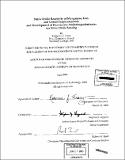Nitric oxide reactivity of manganese, iron and cobalt tropocoronands and development of fluorescent aminotroponiminates for nitric oxide sensing
Author(s)
Franz, Katherine J. (Katherine Jennings), 1972-
DownloadFull printable version (7.700Mb)
Other Contributors
Massachusetts Institute of Technology. Dept. of Chemistry.
Advisor
Stephen J. Lippard.
Terms of use
Metadata
Show full item recordAbstract
Chapter 1. Environmental and Biological Implications of Transition Metal-Nitric Oxide Interactions. This introductory chapter reviews various aspects of NO reactivity by transition metals and in biological systems. Chapter 2. Disproportionation of Nitric Oxide Promoted by a Mn Tropocoronand The first example of a manganese-induced nitric oxide (NO) disproportionation reaction is reported. The synthesis and characterization of divalent [Mn(THF)(TC-5,5)] (1) is presented, along with its reactivity with excess NO to yield N20 and [Mn(NO2)(TC-5,5)] (2). The NO disproportionation involves the formation of a discrete mononitrosyl [Mn(NO)(TC-5,5)j (3), which has been isolated and characterized formally as (MnmNO-) by infrered spectroscopy, normal coordinate analysis, X-ray crystallography and SQUID susceptometry. Chapter 3. NO Disproportionation Reactivity of Fe Tropocoronand Complexes The synthesis and characterization of divalent [Fe(TC-5,5)] (1) and trivalent [Fe(OTf)(TC-5,5)] (2) tropocoronand complexes are described. Compound 1 reacts with one equivalent of NO to form the trigonal bipyramidal (FeNO)7 complex 3, which contains a linearly coordinated nitrosyl (Fe-N-O = 174.3(4)). EPR and M6ssbauer spectroscopy, SQUID susceptometry and normal coordinate analysis indicate 3 to be a low spin (Fem(NO-))2 species. In the presence of excess NO, 3 converts to a metastable nitrosyl-nitrito complex that decomposes by losing NO2. The final products of the NO disproportionation reaction are N2O and [Fe(NO)(TC-5,5-NO2)] (4), a compound that no longer promotes the disproportionation of NO. Mechanistic aspects of the reaction are discussed. Chapter 4. Aminotroponiminates as Ligands for Potential Metal-Based NO Sensors. Part I. Synthesis and Characterization Fluorescently labeled ligands, HRDATI, are described that are composed of aminotroponiminates (ATI) with a dansyl fluorophore on one of the imine nitrogen atoms and an alkyl substituent on the other. (cont.) Bis(chelate) ... complexes were prepared and characterized by X-ray crystallography. The bis-ATI complex [Co(i-Pr2ATI)2] 11 was also prep ared and its X-ray crystal structure determined. When excited at 350 nm, the H DATI ligands and the diamagnetic Zn complex 13 fluoresce around 500 nm, whereas the paramagnetic Co complexes quench the fluorescence. Chapter 5. Aminotroponiminates as Ligands for Potential Metal-Based NO Sensors. Part II. NO Reactivity and Sensing Air-stable cobalt coordination complexes of dansylated aminotroponiminate ligands, [Co(RDATI)2], react with nitric oxide to dissociate a DATI ligand and form neutral dinitrosyl complexes, [Co(NO)2(RDATI)]. The release of the fluorophore-containing ligand is accompanied by an increase in fluorescence intensity, thus providing a strategy for fluorescent NO sensing. Linking two DATI moieties via a 4-methylene chain affords the ligand H2DATI-4. The Co2+ complex [Co(DATI-4)] reacts more readily with NO than the bis-DATI compounds and also demonstrates an increase in fluorescence intensity upon NO binding. Chapter 6. Nitric Oxide Reactivity of Cobalt DenATI, DapATI and Tropocoronand Complexes Dansyl fluorophores are linked to aminotroponiminates via alkyl amine chains to form H2DenATI and H2DapATI ligands ...
Description
Thesis (Ph. D.)--Massachusetts Institute of Technology, Dept. of Chemistry, 2000. Vita. Includes bibliographical references.
Date issued
2000Department
Massachusetts Institute of Technology. Department of ChemistryPublisher
Massachusetts Institute of Technology
Keywords
Chemistry.